Introduction to Accounting and Finance Assignment (Resit): Tasks 1 & 2
VerifiedAdded on 2023/01/12
|7
|1235
|24
Report
AI Summary
This report presents a financial analysis of Merlin Entertainments Plc, comparing its performance in 2017 and 2016 using ratio analysis. The report begins with an executive summary and introduction, followed by a detailed analysis and discussion of various financial ratios, including profitability, liquidity, efficiency, and capital structure. Profitability ratios revealed a decline from 2016 to 2017, attributed to increased operating expenses. Liquidity improved due to a higher cash balance, while efficiency, measured by the receivable collection period, slightly worsened. The capital structure, assessed through dividend cover, also showed a negative trend. The conclusion summarizes the findings, highlighting the deteriorating financial performance in 2017 and emphasizing the need to address falling profitability. The report references several academic sources to support its analysis.
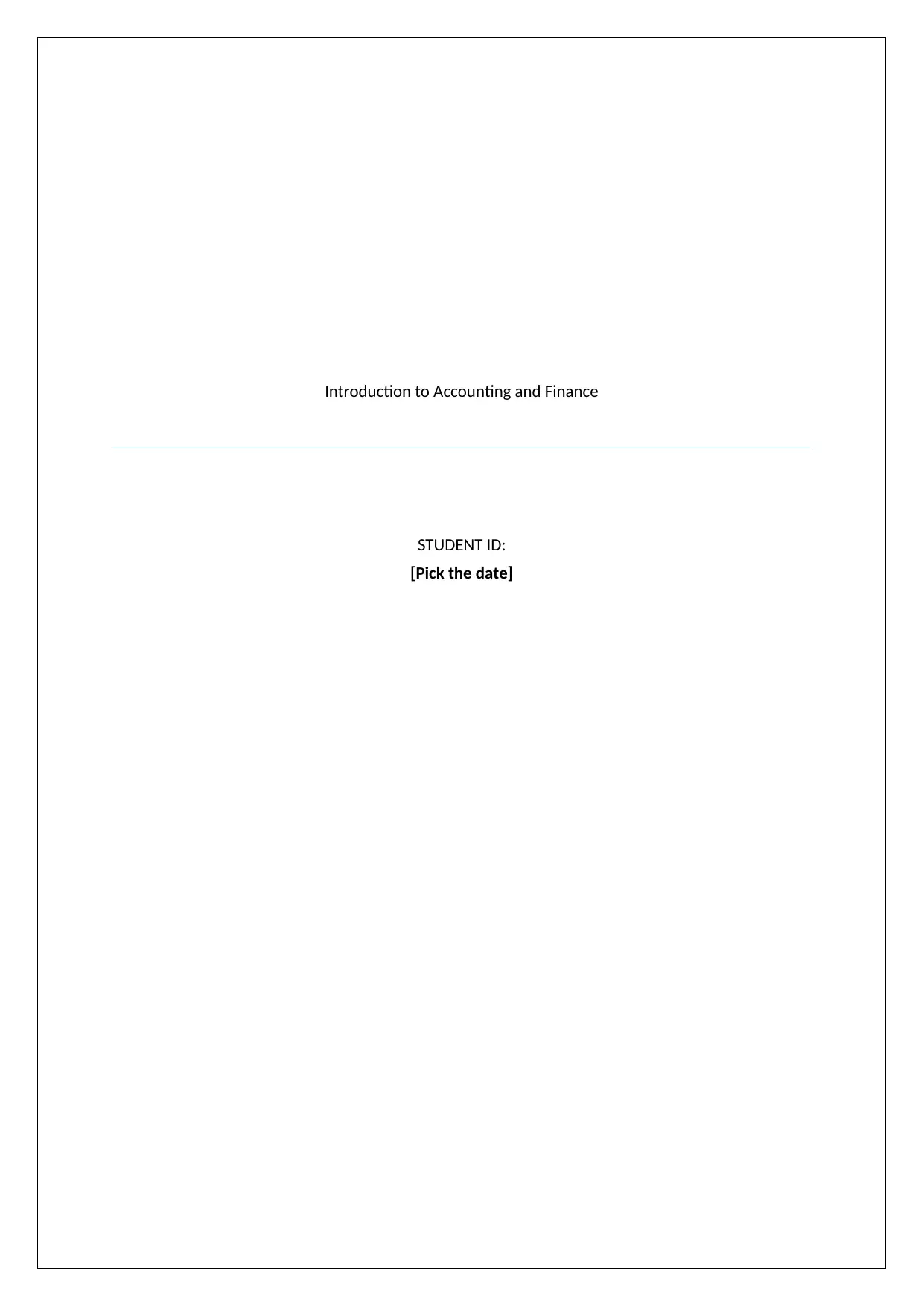
Introduction to Accounting and Finance
STUDENT ID:
[Pick the date]
STUDENT ID:
[Pick the date]
Paraphrase This Document
Need a fresh take? Get an instant paraphrase of this document with our AI Paraphraser

Task 1
The requisite income statement is shown below.
The requisite balance sheet is indicated below.
2
The requisite income statement is shown below.
The requisite balance sheet is indicated below.
2
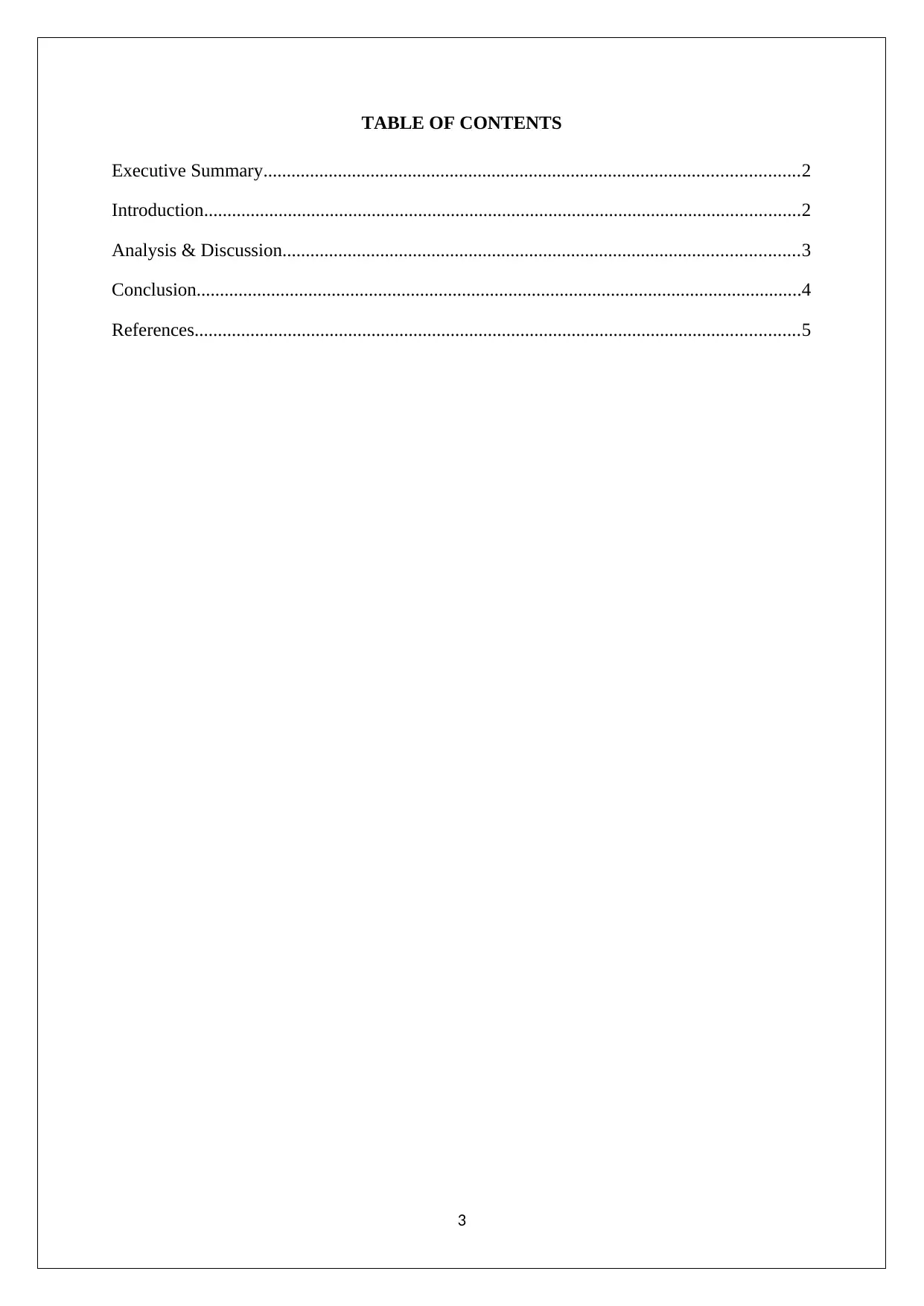
TABLE OF CONTENTS
Executive Summary...................................................................................................................2
Introduction................................................................................................................................2
Analysis & Discussion...............................................................................................................3
Conclusion..................................................................................................................................4
References..................................................................................................................................5
3
Executive Summary...................................................................................................................2
Introduction................................................................................................................................2
Analysis & Discussion...............................................................................................................3
Conclusion..................................................................................................................................4
References..................................................................................................................................5
3
⊘ This is a preview!⊘
Do you want full access?
Subscribe today to unlock all pages.

Trusted by 1+ million students worldwide
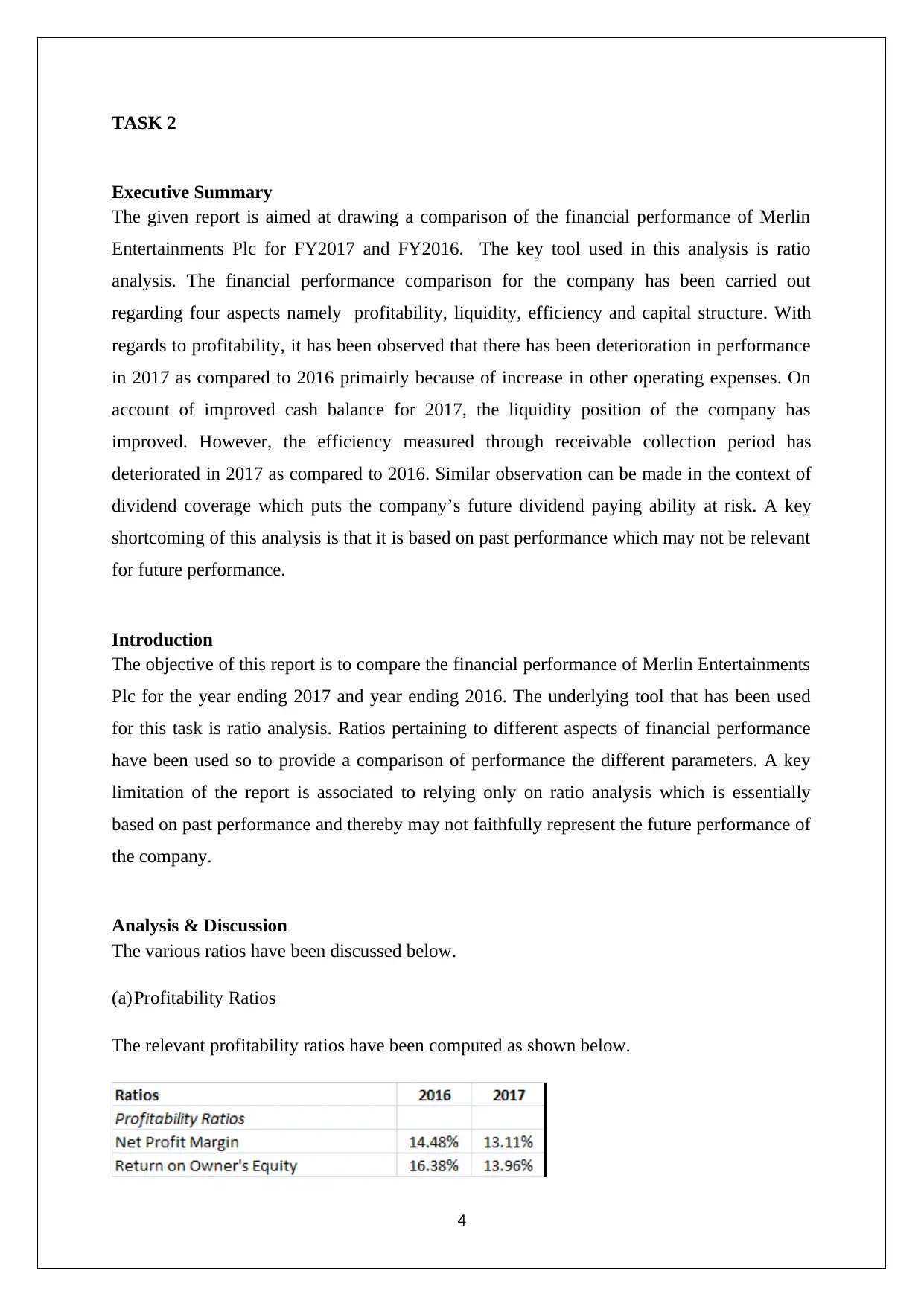
TASK 2
Executive Summary
The given report is aimed at drawing a comparison of the financial performance of Merlin
Entertainments Plc for FY2017 and FY2016. The key tool used in this analysis is ratio
analysis. The financial performance comparison for the company has been carried out
regarding four aspects namely profitability, liquidity, efficiency and capital structure. With
regards to profitability, it has been observed that there has been deterioration in performance
in 2017 as compared to 2016 primairly because of increase in other operating expenses. On
account of improved cash balance for 2017, the liquidity position of the company has
improved. However, the efficiency measured through receivable collection period has
deteriorated in 2017 as compared to 2016. Similar observation can be made in the context of
dividend coverage which puts the company’s future dividend paying ability at risk. A key
shortcoming of this analysis is that it is based on past performance which may not be relevant
for future performance.
Introduction
The objective of this report is to compare the financial performance of Merlin Entertainments
Plc for the year ending 2017 and year ending 2016. The underlying tool that has been used
for this task is ratio analysis. Ratios pertaining to different aspects of financial performance
have been used so to provide a comparison of performance the different parameters. A key
limitation of the report is associated to relying only on ratio analysis which is essentially
based on past performance and thereby may not faithfully represent the future performance of
the company.
Analysis & Discussion
The various ratios have been discussed below.
(a)Profitability Ratios
The relevant profitability ratios have been computed as shown below.
4
Executive Summary
The given report is aimed at drawing a comparison of the financial performance of Merlin
Entertainments Plc for FY2017 and FY2016. The key tool used in this analysis is ratio
analysis. The financial performance comparison for the company has been carried out
regarding four aspects namely profitability, liquidity, efficiency and capital structure. With
regards to profitability, it has been observed that there has been deterioration in performance
in 2017 as compared to 2016 primairly because of increase in other operating expenses. On
account of improved cash balance for 2017, the liquidity position of the company has
improved. However, the efficiency measured through receivable collection period has
deteriorated in 2017 as compared to 2016. Similar observation can be made in the context of
dividend coverage which puts the company’s future dividend paying ability at risk. A key
shortcoming of this analysis is that it is based on past performance which may not be relevant
for future performance.
Introduction
The objective of this report is to compare the financial performance of Merlin Entertainments
Plc for the year ending 2017 and year ending 2016. The underlying tool that has been used
for this task is ratio analysis. Ratios pertaining to different aspects of financial performance
have been used so to provide a comparison of performance the different parameters. A key
limitation of the report is associated to relying only on ratio analysis which is essentially
based on past performance and thereby may not faithfully represent the future performance of
the company.
Analysis & Discussion
The various ratios have been discussed below.
(a)Profitability Ratios
The relevant profitability ratios have been computed as shown below.
4
Paraphrase This Document
Need a fresh take? Get an instant paraphrase of this document with our AI Paraphraser
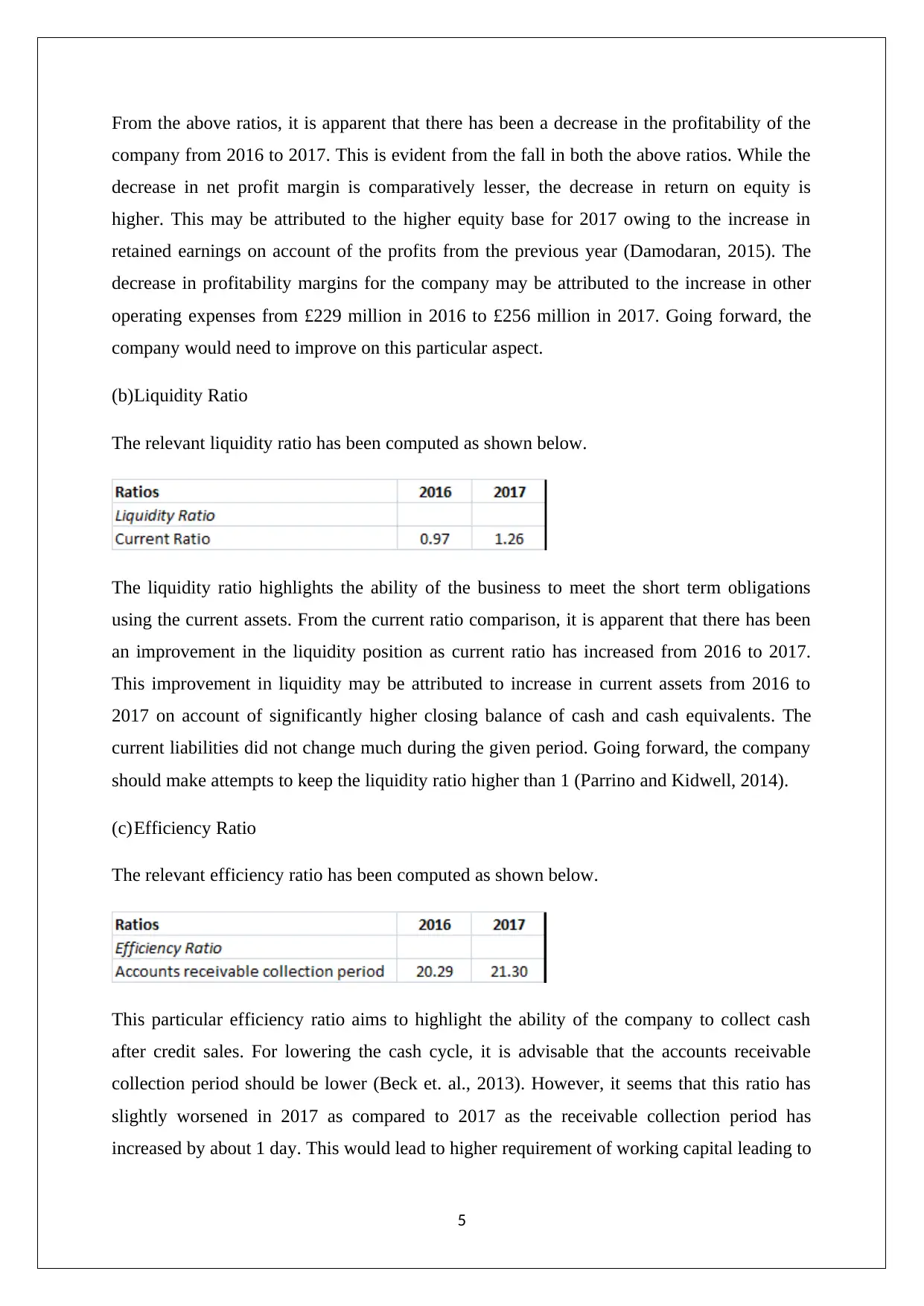
From the above ratios, it is apparent that there has been a decrease in the profitability of the
company from 2016 to 2017. This is evident from the fall in both the above ratios. While the
decrease in net profit margin is comparatively lesser, the decrease in return on equity is
higher. This may be attributed to the higher equity base for 2017 owing to the increase in
retained earnings on account of the profits from the previous year (Damodaran, 2015). The
decrease in profitability margins for the company may be attributed to the increase in other
operating expenses from £229 million in 2016 to £256 million in 2017. Going forward, the
company would need to improve on this particular aspect.
(b)Liquidity Ratio
The relevant liquidity ratio has been computed as shown below.
The liquidity ratio highlights the ability of the business to meet the short term obligations
using the current assets. From the current ratio comparison, it is apparent that there has been
an improvement in the liquidity position as current ratio has increased from 2016 to 2017.
This improvement in liquidity may be attributed to increase in current assets from 2016 to
2017 on account of significantly higher closing balance of cash and cash equivalents. The
current liabilities did not change much during the given period. Going forward, the company
should make attempts to keep the liquidity ratio higher than 1 (Parrino and Kidwell, 2014).
(c)Efficiency Ratio
The relevant efficiency ratio has been computed as shown below.
This particular efficiency ratio aims to highlight the ability of the company to collect cash
after credit sales. For lowering the cash cycle, it is advisable that the accounts receivable
collection period should be lower (Beck et. al., 2013). However, it seems that this ratio has
slightly worsened in 2017 as compared to 2017 as the receivable collection period has
increased by about 1 day. This would lead to higher requirement of working capital leading to
5
company from 2016 to 2017. This is evident from the fall in both the above ratios. While the
decrease in net profit margin is comparatively lesser, the decrease in return on equity is
higher. This may be attributed to the higher equity base for 2017 owing to the increase in
retained earnings on account of the profits from the previous year (Damodaran, 2015). The
decrease in profitability margins for the company may be attributed to the increase in other
operating expenses from £229 million in 2016 to £256 million in 2017. Going forward, the
company would need to improve on this particular aspect.
(b)Liquidity Ratio
The relevant liquidity ratio has been computed as shown below.
The liquidity ratio highlights the ability of the business to meet the short term obligations
using the current assets. From the current ratio comparison, it is apparent that there has been
an improvement in the liquidity position as current ratio has increased from 2016 to 2017.
This improvement in liquidity may be attributed to increase in current assets from 2016 to
2017 on account of significantly higher closing balance of cash and cash equivalents. The
current liabilities did not change much during the given period. Going forward, the company
should make attempts to keep the liquidity ratio higher than 1 (Parrino and Kidwell, 2014).
(c)Efficiency Ratio
The relevant efficiency ratio has been computed as shown below.
This particular efficiency ratio aims to highlight the ability of the company to collect cash
after credit sales. For lowering the cash cycle, it is advisable that the accounts receivable
collection period should be lower (Beck et. al., 2013). However, it seems that this ratio has
slightly worsened in 2017 as compared to 2017 as the receivable collection period has
increased by about 1 day. This would lead to higher requirement of working capital leading to
5
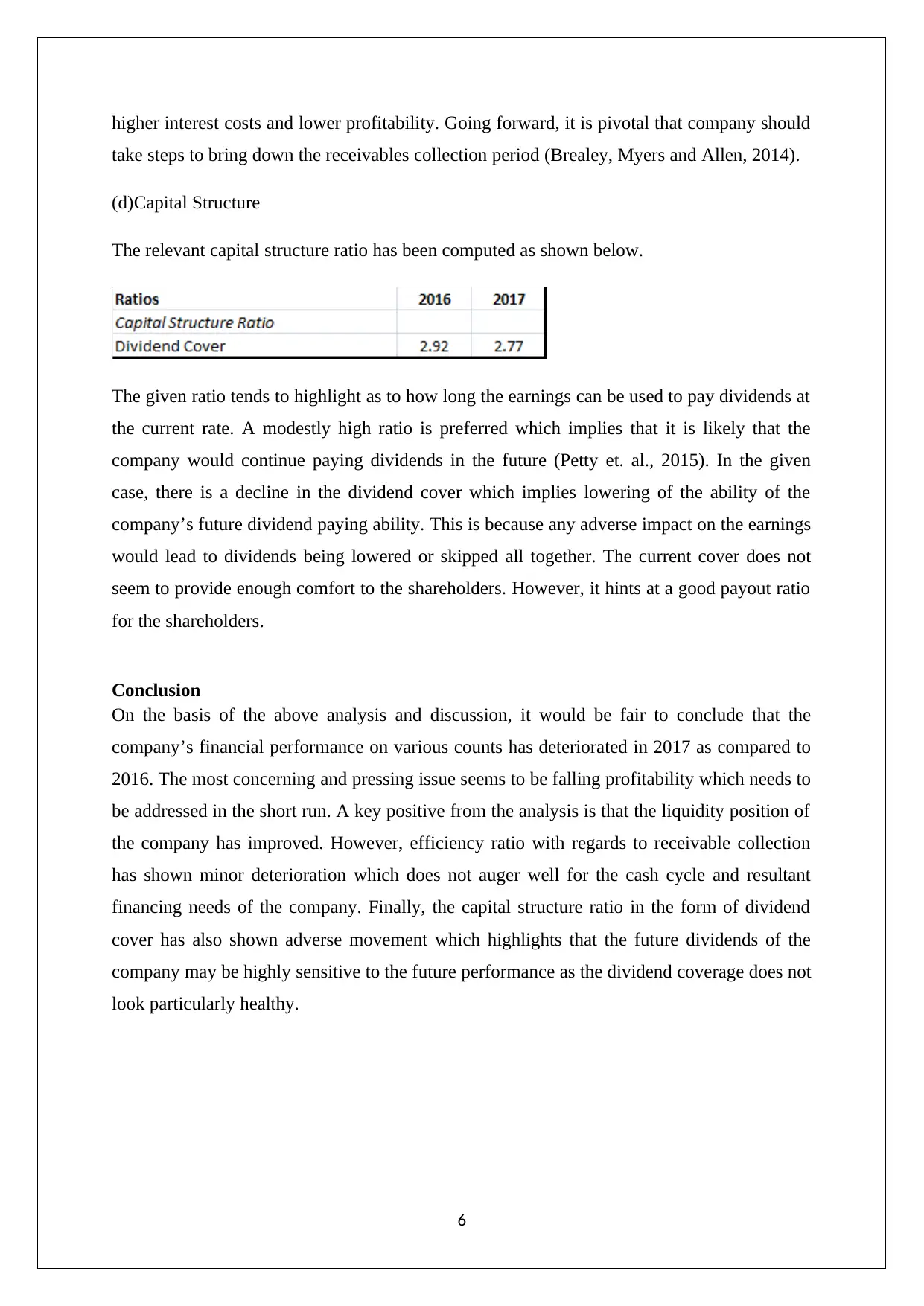
higher interest costs and lower profitability. Going forward, it is pivotal that company should
take steps to bring down the receivables collection period (Brealey, Myers and Allen, 2014).
(d)Capital Structure
The relevant capital structure ratio has been computed as shown below.
The given ratio tends to highlight as to how long the earnings can be used to pay dividends at
the current rate. A modestly high ratio is preferred which implies that it is likely that the
company would continue paying dividends in the future (Petty et. al., 2015). In the given
case, there is a decline in the dividend cover which implies lowering of the ability of the
company’s future dividend paying ability. This is because any adverse impact on the earnings
would lead to dividends being lowered or skipped all together. The current cover does not
seem to provide enough comfort to the shareholders. However, it hints at a good payout ratio
for the shareholders.
Conclusion
On the basis of the above analysis and discussion, it would be fair to conclude that the
company’s financial performance on various counts has deteriorated in 2017 as compared to
2016. The most concerning and pressing issue seems to be falling profitability which needs to
be addressed in the short run. A key positive from the analysis is that the liquidity position of
the company has improved. However, efficiency ratio with regards to receivable collection
has shown minor deterioration which does not auger well for the cash cycle and resultant
financing needs of the company. Finally, the capital structure ratio in the form of dividend
cover has also shown adverse movement which highlights that the future dividends of the
company may be highly sensitive to the future performance as the dividend coverage does not
look particularly healthy.
6
take steps to bring down the receivables collection period (Brealey, Myers and Allen, 2014).
(d)Capital Structure
The relevant capital structure ratio has been computed as shown below.
The given ratio tends to highlight as to how long the earnings can be used to pay dividends at
the current rate. A modestly high ratio is preferred which implies that it is likely that the
company would continue paying dividends in the future (Petty et. al., 2015). In the given
case, there is a decline in the dividend cover which implies lowering of the ability of the
company’s future dividend paying ability. This is because any adverse impact on the earnings
would lead to dividends being lowered or skipped all together. The current cover does not
seem to provide enough comfort to the shareholders. However, it hints at a good payout ratio
for the shareholders.
Conclusion
On the basis of the above analysis and discussion, it would be fair to conclude that the
company’s financial performance on various counts has deteriorated in 2017 as compared to
2016. The most concerning and pressing issue seems to be falling profitability which needs to
be addressed in the short run. A key positive from the analysis is that the liquidity position of
the company has improved. However, efficiency ratio with regards to receivable collection
has shown minor deterioration which does not auger well for the cash cycle and resultant
financing needs of the company. Finally, the capital structure ratio in the form of dividend
cover has also shown adverse movement which highlights that the future dividends of the
company may be highly sensitive to the future performance as the dividend coverage does not
look particularly healthy.
6
⊘ This is a preview!⊘
Do you want full access?
Subscribe today to unlock all pages.

Trusted by 1+ million students worldwide
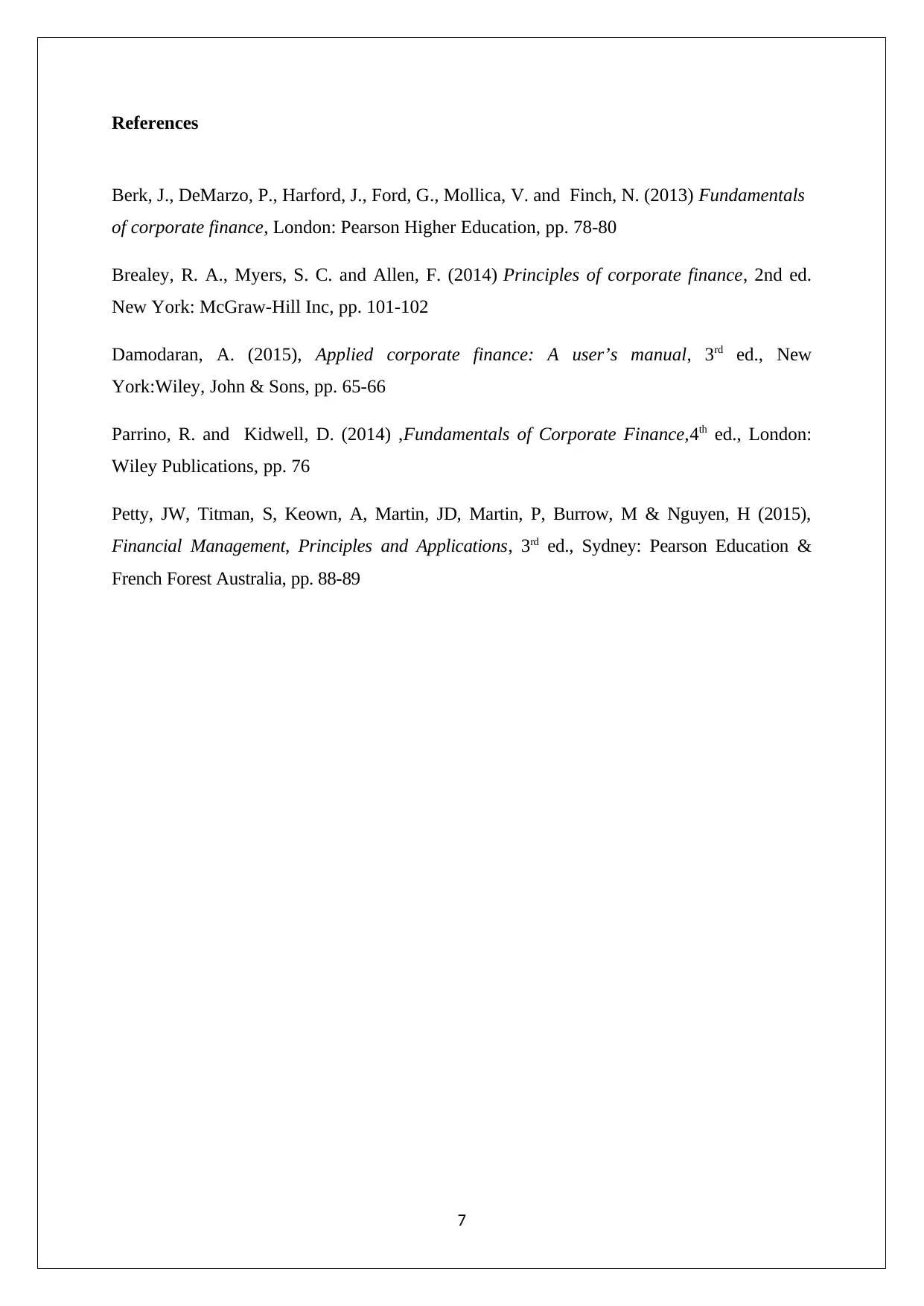
References
Berk, J., DeMarzo, P., Harford, J., Ford, G., Mollica, V. and Finch, N. (2013) Fundamentals
of corporate finance, London: Pearson Higher Education, pp. 78-80
Brealey, R. A., Myers, S. C. and Allen, F. (2014) Principles of corporate finance, 2nd ed.
New York: McGraw-Hill Inc, pp. 101-102
Damodaran, A. (2015), Applied corporate finance: A user’s manual, 3rd ed., New
York:Wiley, John & Sons, pp. 65-66
Parrino, R. and Kidwell, D. (2014) ,Fundamentals of Corporate Finance,4th ed., London:
Wiley Publications, pp. 76
Petty, JW, Titman, S, Keown, A, Martin, JD, Martin, P, Burrow, M & Nguyen, H (2015),
Financial Management, Principles and Applications, 3rd ed., Sydney: Pearson Education &
French Forest Australia, pp. 88-89
7
Berk, J., DeMarzo, P., Harford, J., Ford, G., Mollica, V. and Finch, N. (2013) Fundamentals
of corporate finance, London: Pearson Higher Education, pp. 78-80
Brealey, R. A., Myers, S. C. and Allen, F. (2014) Principles of corporate finance, 2nd ed.
New York: McGraw-Hill Inc, pp. 101-102
Damodaran, A. (2015), Applied corporate finance: A user’s manual, 3rd ed., New
York:Wiley, John & Sons, pp. 65-66
Parrino, R. and Kidwell, D. (2014) ,Fundamentals of Corporate Finance,4th ed., London:
Wiley Publications, pp. 76
Petty, JW, Titman, S, Keown, A, Martin, JD, Martin, P, Burrow, M & Nguyen, H (2015),
Financial Management, Principles and Applications, 3rd ed., Sydney: Pearson Education &
French Forest Australia, pp. 88-89
7
1 out of 7
Related Documents
Your All-in-One AI-Powered Toolkit for Academic Success.
+13062052269
info@desklib.com
Available 24*7 on WhatsApp / Email
![[object Object]](/_next/static/media/star-bottom.7253800d.svg)
Unlock your academic potential
Copyright © 2020–2025 A2Z Services. All Rights Reserved. Developed and managed by ZUCOL.





